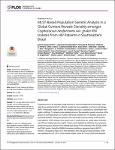MLST-Based Population Genetic Analysis in a Global Context Reveals Clonality amongst Cryptococcus neoformans var. grubii VNI Isolates from HIV Patients in Southeastern Brazil
Ferreira-Paim, Kennio
Andrade-Silva, Leonardo
Fonseca, Fernanda M.
Ferreira, Thatiana B.
Mora, Delio J.
Andrade-Silva, Juliana
Khan, Aziza
Dao, Aiken
Reis, Eduardo C.
Almeida, Margarete T. G.
Maltos, Andre
Junior, Virmondes R.
Trilles, Luciana
Rickerts, Volker
Chindamporn, Ariya
Sykes, Jane E.
Cogliati, Massimo
Nielsen, Kirsten
Boekhout, Teun
Fisher, Matthew
Kwon-Chung, June
Engelthaler, David M.
Lazéra, Marcia
Meyer, Wieland
Silva-Vergara, Mario L.
Cryptococcosis is an important fungal infection in immunocompromised individuals, especially those infected with HIV. In Brazil, despite the free availability of antiretroviral therapy (ART) in the public health system, the mortality rate due to Cryptococcus neoformans meningitis is still high. To obtain a more detailed picture of the population genetic structure of this species in southeast Brazil, we studied 108 clinical isolates from 101 patients and 35 environmental isolates. Among the patients, 59% had a fatal outcome mainly in HIV-positive male patients. All the isolates were found to be C. neoformans var. grubii major molecular type VNI and mating type locus alpha. Twelve were identified as diploid by flow cytometry, being homozygous (AαAα) for the mating type and by PCR screening of the STE20, GPA1, and PAK1 genes. Using the ISHAM consensus multilocus sequence typing (MLST) scheme, 13 sequence types (ST) were identified, with one being newly described. ST93 was identified from 81 (75%) of the clinical isolates, while ST77 and ST93 were identified from 19 (54%) and 10 (29%) environmental isolates, respectively. The southeastern Brazilian isolates had an overwhelming clonal population structure. When compared with populations from different continents based on data extracted from the ISHAM-MLST database (mlst.mycologylab.org) they showed less genetic variability. Two main clusters within C. neoformans var. grubii VNI were identified that diverged from VNB around 0.58 to 4.8 million years ago.
No license information

